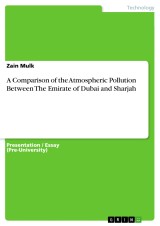Details

A Comparison of the Atmospheric Pollution Between The Emirate of Dubai and Sharjah
1. Auflage
|
5,99 € |
|
| Verlag: | Grin Verlag |
| Format: | |
| Veröffentl.: | 22.08.2019 |
| ISBN/EAN: | 9783346002372 |
| Sprache: | englisch |
| Anzahl Seiten: | 13 |
Dieses eBook erhalten Sie ohne Kopierschutz.
Beschreibungen
Presentation / Essay (Pre-University) from the year 2019 in the subject Environmental Sciences, grade: A* (36/40), , course: Environmental Science, language: English, abstract: This research essay will aim to differentiate the levels of atmospheric pollution between the two cities of Sharjah and Dubai through the usage of extensive primary data collection and established secondary data. There are six key factors: a general consensus, weather conditions and visibility, air pollution indices, traffic counts, city-specific lists and governmental data.
Air Pollution within the UAE is a prevalent issue and has been for decades on end. The situation only seems to be getting worse, due to the collateral effects of urbanization. Dubai expects to host 25 million new visitors, thus the city looks to expand its urban sprawl, taking into account new construction projects, a greater population influx and higher numbers of vehicular usage (motorisation).
Worldpopulationreview.com reported that Dubai's population has been increasing at a rate of 10.3% as of late 2016, making it one of the world's fastest-growing cities. Sharjah on the other hand, a city 30km away from Dubai, also seems to be expanding, through growing industrial activity and a greater number of labour and working-class residents settling in the Emirate within a relatively small surface area.
A high frequency of factories litter Sharjah's industrial areas, and densely packed traffic of heavy vehicles going to and coming from Dubai feed into the fumes released into the atmosphere. Moreover, both cities lie close to Dubai International Airport, one of the world's busiest and most crowded airports. Lastly, Dubai possesses a greater density of vegetation per sq km due to scattered golf courses, green neighbourhoods and public parks. As for Sharjah, it is clear that a majority of the land area is occupied by residential buildings, factories and offices; with fewer parks and vegetational cover.
It is evident that a myriad of factors come into play when determining the levels of air pollution between the two cities and it is crucial to compare the various effects and impacts of air pollution on the people of each city.
Air Pollution within the UAE is a prevalent issue and has been for decades on end. The situation only seems to be getting worse, due to the collateral effects of urbanization. Dubai expects to host 25 million new visitors, thus the city looks to expand its urban sprawl, taking into account new construction projects, a greater population influx and higher numbers of vehicular usage (motorisation).
Worldpopulationreview.com reported that Dubai's population has been increasing at a rate of 10.3% as of late 2016, making it one of the world's fastest-growing cities. Sharjah on the other hand, a city 30km away from Dubai, also seems to be expanding, through growing industrial activity and a greater number of labour and working-class residents settling in the Emirate within a relatively small surface area.
A high frequency of factories litter Sharjah's industrial areas, and densely packed traffic of heavy vehicles going to and coming from Dubai feed into the fumes released into the atmosphere. Moreover, both cities lie close to Dubai International Airport, one of the world's busiest and most crowded airports. Lastly, Dubai possesses a greater density of vegetation per sq km due to scattered golf courses, green neighbourhoods and public parks. As for Sharjah, it is clear that a majority of the land area is occupied by residential buildings, factories and offices; with fewer parks and vegetational cover.
It is evident that a myriad of factors come into play when determining the levels of air pollution between the two cities and it is crucial to compare the various effects and impacts of air pollution on the people of each city.
Diese Produkte könnten Sie auch interessieren:

Proceedings of the 2007 National Conference on Environmental Science and Technology

von: Godfrey Uzochukwu, Keith Schimmel, Shoou-Yuh Chang, Vinayak Kabadi, Stephanie Luster-Teasley, Gudigopuram Reddy, Emmanuel Nzewi

149,79 €















